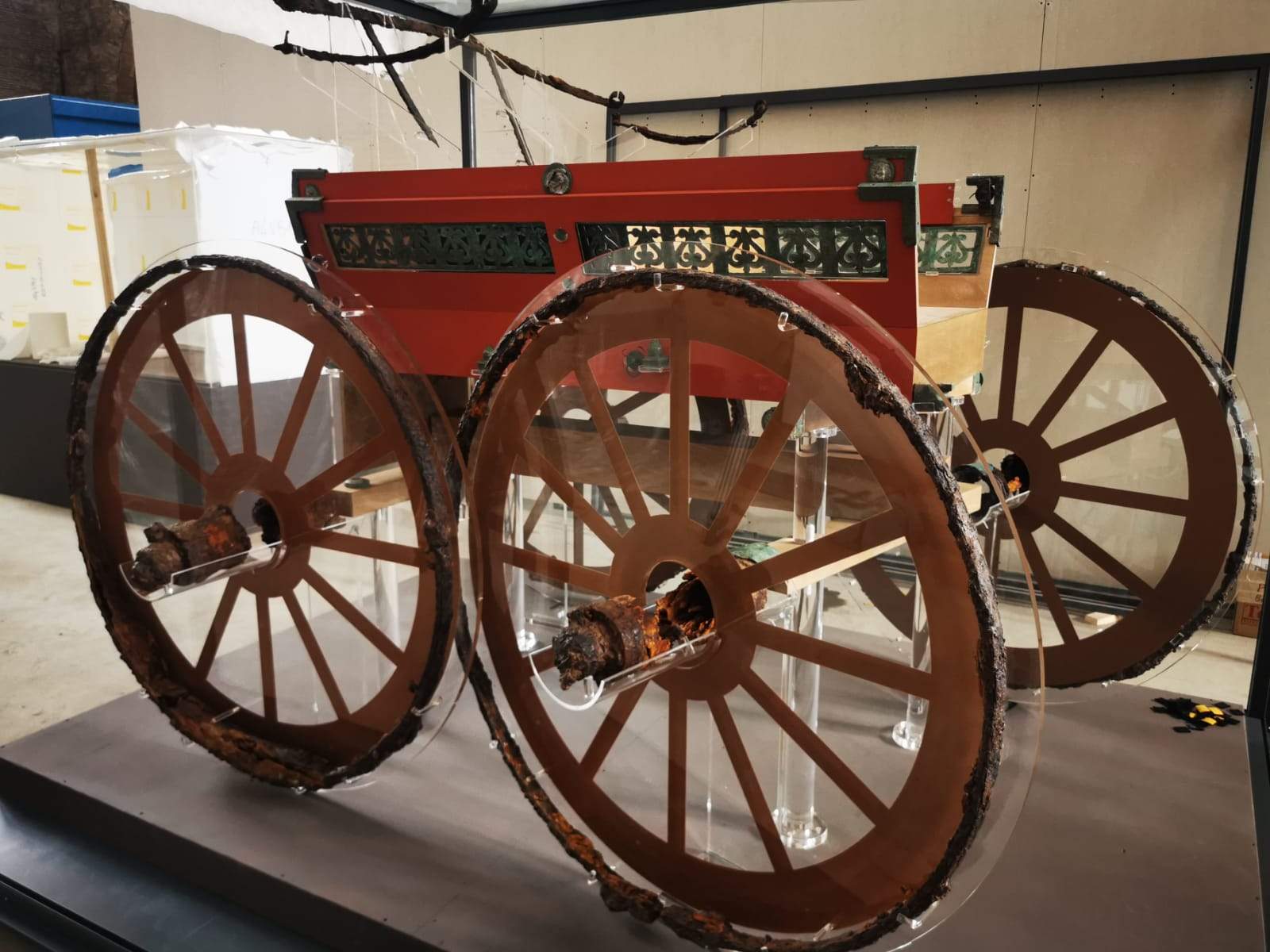The parade chariot found in 2019 at Civita Giuliana, a locality north of Pompeii, in a suburban villa already partly identified and investigated in the early 20th century and returned to attention due to clandestine excavations conducted by grave robbers, has been reconstructed. The ceremonial chariot, with a luxurious bronze lining and silver decorations, presented itself to archaeologists in an excellent state of preservation. Four years after its discovery, reconstruction work has been completed: the missing parts have left impressions in the ashes and have been reconstructed using the cast technique so that the public can perceive its real shape and size. The date to see it is the exhibition The Instant and Eternity. Between Us and the Ancients, scheduled from May 4 to July 30, 2023 at the National Roman Museum in Rome.
The story of the float originated in 2017 when the Torre Annunziata Public Prosecutor’s Office, the Carabinieri of the Nucleo Tutela Patrimonio Culturale and the Pompeii Archaeological Park decided to collaborate to stop the illegal activity of illegal immigrants and the looting of the archaeological heritage of the Civita Giuliana area. From this synergy, which gave rise in 2019 to a Memorandum of Understanding for Legality between the institutions aimed at combating illegal operations in the Vesuvian area, and from the excavation activity initiated, the result was the discovery and thus the return to the public of environments and artifacts of great value from a historical and scientific point of view, including the newly reconstructed ceremonial chariot.
The large four-wheeled parade chariot, with its iron elements, bronze and silver decorations with erotic depictions, mineralized wooden remains, and imprints of organic elements (from ropes to remnants of plant decorations), was found in excellent condition in the porch in front of the stable. It was immediately clear that this was a unicum in Italy not only because of the level of preservation, as individual decorations and the entire structure of the vehicle emerged, but also because it was not configured as a chariot for transporting agricultural products or for the activities of daily life, already attested at both Pompeii and Stabia. The chariot is identifiable, according to experts, as a pilentum, a vehicle used in the Roman world by elites, for ceremonies and in particular to accompany the bride to her new home. A unique and fragile find due to its delicate condition of preservation and discovery, which in its recovery, restoration, reconstruction and return to public enjoyment, fully embodies the sense of transience and eternity that history delivers to us through the testimony of our extraordinary cultural heritage.
“This is an authentic gem that demonstrates even more, should there be any need, the uniqueness of our heritage,” says Culture Minister Gennaro Sangiuliano. “The restoration and exhibition represent not only the return of an exceptional find to citizens and scholars, but also the crowning achievement of an effort that, in this case, has seen the Archaeological Park of Pompeii, the Torre Annunziata Public Prosecutor’s Office and the Carabinieri of the TPC working together. All this encourages us to work with ever greater commitment, aware of the value of our heritage, the legacy of a great past but also an opportunity for civil and socioeconomic growth for the future.”
“The discovery at the time of the excavation was exceptional in terms of the information it revealed about the type of transport vehicle, ceremonial in nature, which found no comparison in Italy with similar finds,” says Massimo Osanna, director general of museums under whose direction the Pompeii Park excavation activities that led to the discovery of the chariot were launched in 2018. "A similar chariot had been found years ago in Greece, in the sites of ancient Thrace, in a tomb belonging to a high-ranking family, but left in situ. In contrast, this is the first time in the world that a pilentum has been reconstructed and studied. In addition, the investigations at Civita Giuliana sanctioned the implementation of a whole-context excavation methodology, now commonplace in Pompeii, involving an interdisciplinary team of archaeologists, architects, engineers, restorers, volcanologists, anthropologists and archaeobotanists. The current return of the chariot to the public encapsulates a much broader story of caring for Italy’s cultural heritage."
“The chariot, in addition to its scientific value, constitutes the symbol of a virtuous process of legality, protection and enhancement not only of individual artifacts, but of the entire Vesuvian territory,” adds Gabriel Zuchtriegel, director of the Archaeological Park of Pompeii. “That activity initiated expropriation operations of illicit structures to allow the investigation to continue and saw multiple entities collaborate for a unified intent. In addition to the Public Prosecutor’s Office and the Carabinieri, the Municipality of Pompeii, too, has lent its willingness in managing the urban road system inevitably compromised by the continuation of the excavation. The exhibition of the precious finds is a starting point toward the more ambitious goal of soon making the entire villa accessible to the public.”
The exhibition displaying the chariot is sponsored by the Italian Ministry of Culture and the Ministry of Culture and Sports of Greece (Ephorate for Antiquities of the Cyclades) and is intended to testify to the centrality and importance of the collaboration between the two states. The exhibition event, organized by the General Directorate for Museums and the National Roman Museum in collaboration with Electa, is conceived and curated by Massimo Osanna, Stéphane Verger, Maria Luisa Catoni and Demetrios Athanasoulis, with the support of the Archaeological Park of Pompeii and the participation of the Scuola IMT Alti Studi Lucca and the Scuola Superiore Meridionale.
 |
| Pompeii, reconstructed rare parade chariot discovered in 2019. It can be seen in Rome |
Warning: the translation into English of the original Italian article was created using automatic tools. We undertake to review all articles, but we do not guarantee the total absence of inaccuracies in the translation due to the program. You can find the original by clicking on the ITA button. If you find any mistake,please contact us.